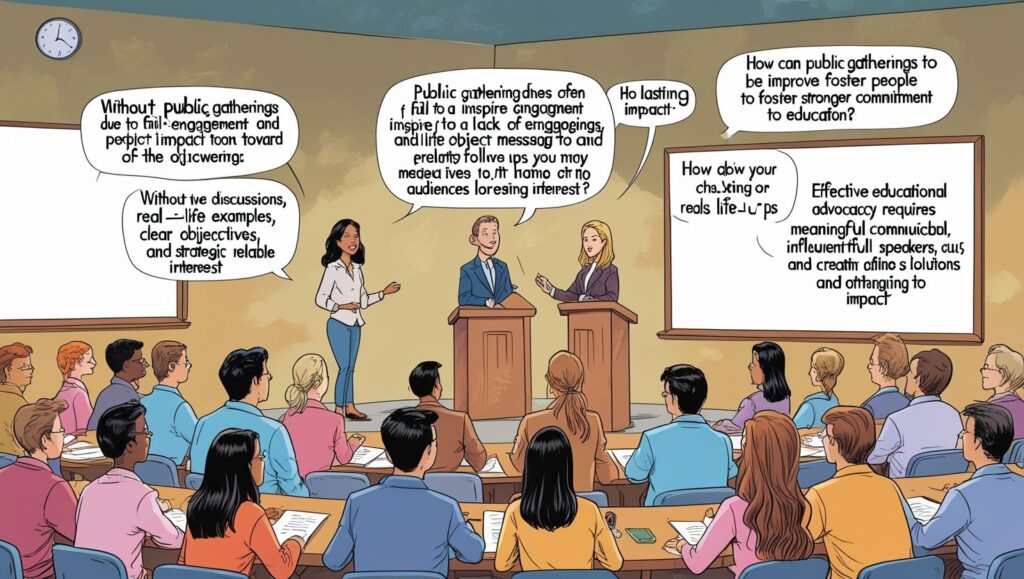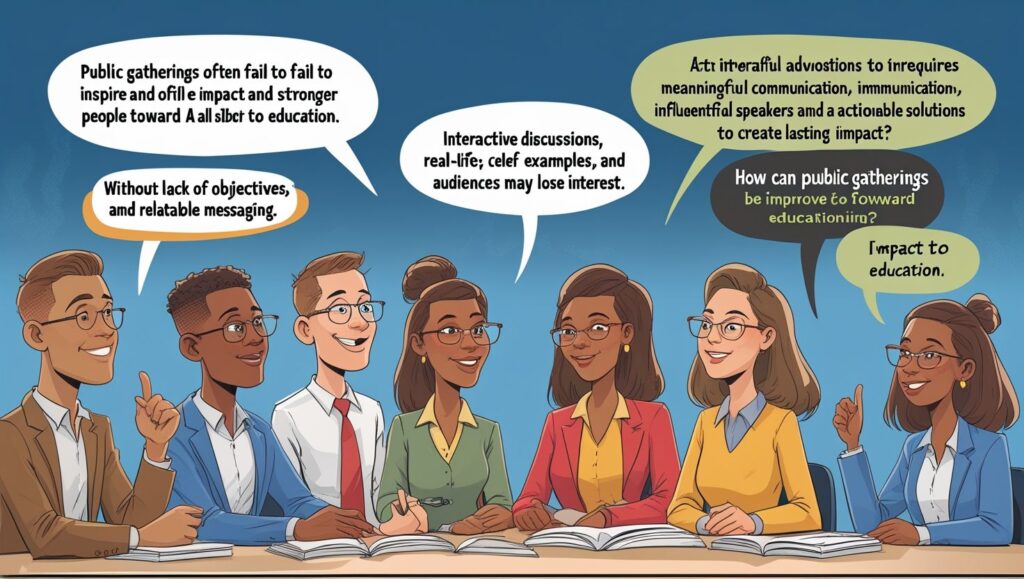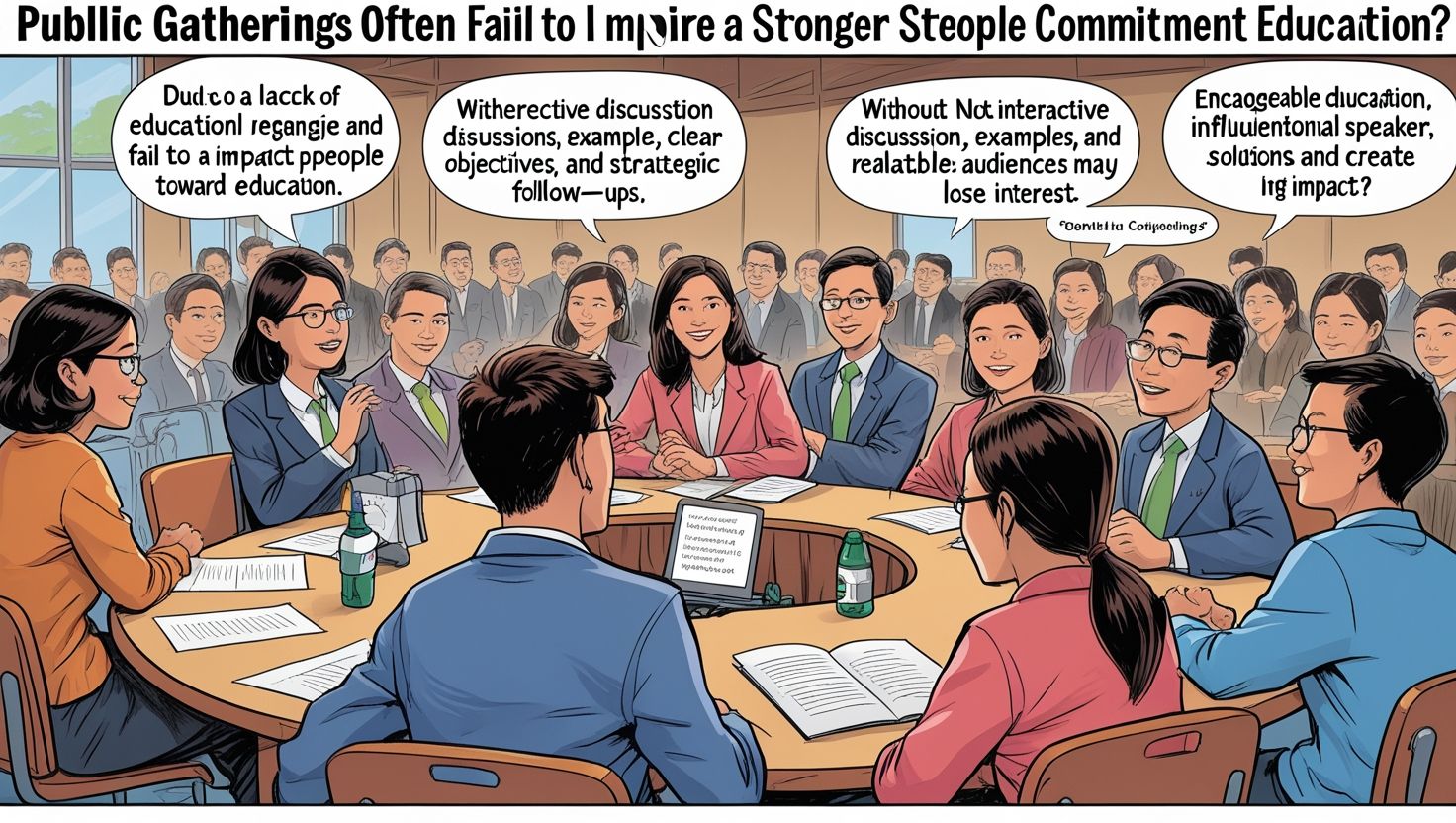Introduction
Gatherings Fail to Inspire and Impact People Towards Education, Public gatherings—rallies, marches, and awareness campaigns—are commonly organized to promote education, advocate for policy changes, and inspire communities to value learning. From global movements like Malala Yousafzai’s education activism to local school enrollment drives, these events aim to create momentum for educational improvement. However, despite good intentions, many such gatherings fail to produce lasting change in attitudes, enrollment rates, or learning outcomes.
Why do these efforts often fall short? This article examines the key reasons why public gatherings frequently fail to inspire meaningful progress in education. We explore issues such as superficial engagement, lack of follow-through, cultural barriers, government inefficiency, and the absence of grassroots ownership. By understanding these challenges, we can develop more effective strategies to mobilize communities toward real educational transformation.
1. Superficial Messaging Without Clear Action Plans
The Problem: Vague Slogans, Weak Impact
Many educational campaigns revolve around broad slogans like “Education for All” or “Save Our Schools,” which sound inspiring but lack concrete steps for implementation. Without specific goals, these gatherings become symbolic rather than actionable.
Why It Happens:
- Overly General Demands – Slogans like “End Illiteracy” don’t specify who should act or how.
- No Defined Audience – Messages often fail to target key decision-makers (policymakers, parents, or teachers).
- Symbolism Over Substance – Rallies focus on raising awareness rather than solving problems.
Example:
Gatherings Fail to Inspire and Impact People Towards Education, In India, the Right to Education Act (2009) was a landmark policy, but many public rallies failed to address local issues like teacher absenteeism or poor infrastructure, limiting real change.
Solution:
- Set specific, measurable demands (e.g., “Hire 100 new teachers in District X by 2025”).
- Direct appeals to policymakers, parents, and educators with tailored messages.
2. Lack of Sustained Follow-Up After the Event
The Problem: One-Time Protests, No Long-Term Strategy
A single rally or march may generate media attention, but without continuous pressure, momentum fades quickly.
Why It Happens:
- No Post-Event Planning – Many gatherings disband without a strategy for lobbying, community programs, or policy monitoring.
- Over-Reliance on Government Action – Activists expect officials to act but fail to hold them accountable.
- Volunteer Burnout – Passion diminishes when there are no short-term wins.
Example:
Nigeria’s #BringBackOurGirls campaign drew global attention to school safety, but after initial protests, little was done to improve long-term security for students.
Solution:
- Develop a multi-phase campaign (protests + petitions + policy meetings).
- Create local watchdog groups to monitor government promises.

3. Cultural and Socioeconomic Barriers
The Problem: Deep-Rooted Social Norms Undermine Efforts
In many communities, poverty, child labor, and gender bias prevent families from prioritizing education.
Why It Happens:
- Economic Pressures – Poor families rely on children for labor or income.
- Gender Discrimination – Girls are often pulled out of school for early marriage.
- Distrust of Formal Education – Some communities see schooling as irrelevant to their livelihoods.
Example:
In rural Pakistan, public rallies promoting girls’ education often fail because families fear cultural backlash or see no economic benefit.
Solution:
- Engage local leaders (religious figures, elders) to shift cultural attitudes.
- Offer incentives (school meals, stipends) to offset lost income from child labor.
4. Government Inefficiency and Corruption
The Problem: Good Intentions, Poor Execution
Gatherings Fail to Inspire and Impact People Towards Education, Even when public gatherings demand reforms, bureaucratic delays and corruption block progress.
Why It Happens:
- Funds Mismanagement – Money meant for schools is diverted or stolen.
- Slow Policy Implementation – Governments announce reforms but take years to act.
- Political Indifference – Leaders ignore protests if they don’t see electoral benefits.
Example:
In Kenya, protests over textbook shortages led to government promises, but corruption kept supplies from reaching schools.
Solution:
- Demand transparent budgeting for education funds.
- Use legal action (public interest lawsuits) to force accountability.
5. Lack of Grassroots Involvement
The Problem: Top-Down Campaigns Miss Local Realities
Many education movements are led by urban activists who don’t understand rural challenges.
Why It Happens:
- No Community Ownership – Locals don’t lead, so they don’t sustain the movement.
- Language and Communication Gaps – Messages don’t resonate if delivered in formal or unfamiliar dialects.
- Ignoring Local Solutions – Pre-packaged campaigns fail to address unique community needs.
Solution:
- Train local advocates (parents, teachers, students) to lead campaigns.
- Use community radio, theater, or storytelling to spread messages effectively.

6. Media Desensitization and Short Attention Spans
The Problem: Education Struggles to Compete for Attention
News cycles prioritize sensational headlines over long-term educational issues.
Why It Happens:
- “Boring” Topic – School reforms get less coverage than political scandals.
- Temporary Viral Trends – Hashtags like #SaveOurSchools trend briefly, then fade.
- Misrepresentation – Media may focus on protest violence rather than educational demands.
Example:
South Africa’s #FeesMustFall protests initially gained attention, but media soon shifted focus to clashes rather than tuition reforms.
Solution:
- Partner with journalists and influencers to keep focus on education.
- Use documentaries or student storytelling to humanize the issue.
7. Over-Reliance on Celebrities and Symbolism
The Problem: Star Power Without Substance
Celebrity endorsements can draw crowds but often lack depth in driving real change.
Why It Happens:
- Photo-Ops Over Policy – Famous faces join for publicity, not problem-solving.
- No Local Role Models – Communities need relatable advocates, not distant influencers.
- Celebrities Move On – Their attention shifts to the next trending cause.
Example:
While Malala Yousafzai inspires globally, some conservative communities distrust her Western ties, reducing local impact.
Solution:
- Elevate local heroes (teachers, students) as spokespeople.
- Ensure celebrities commit long-term, not just for one event.
8. Failure to Address Systemic Issues
The Problem: Treating Symptoms, Not Root Causes
Many gatherings focus on surface-level fixes (e.g., “Build More Schools”) rather than deeper issues (e.g., poor teaching quality).
Why It Happens:
- Band-Aid Solutions – Donating books doesn’t fix flawed curricula.
- Ignoring Teacher Motivation – Low salaries and burnout affect education quality.
- No Holistic Approach – Education ties into healthcare, jobs, and infrastructure.
Example:
In the Philippines, protests demanded classroom repairs but didn’t push for teacher training reforms, so learning outcomes stayed weak.
Solution:
- Advocate for systemic reforms (teacher training, updated curricula).
- Link education to broader development goals (jobs, health).
Conclusion: How to Make Educational Gatherings Effective
For public gatherings to truly inspire change in education, they must:
- Set Specific Demands – Move beyond slogans to actionable policy asks.
- Engage Local Communities – Let parents, students, and teachers lead.
- Combine Protests with Policy Work – Follow rallies with petitions, meetings, and monitoring.
- Use Grassroots Communication – Speak in local languages and address cultural barriers.
- Leverage Media Strategically – Partner with journalists to sustain focus.
Without these steps, public gatherings will remain symbolic rather than transformative. Real educational change requires not just raising voices but ensuring they lead to action, accountability, and systemic reform.
Conclusion
Public gatherings, despite their potential to mobilize masses and amplify voices, often fall short of creating lasting impact in education. While rallies, marches, and awareness campaigns generate temporary attention, they frequently fail to translate into tangible improvements in enrollment rates, learning outcomes, or policy reforms. The reasons for this disconnect are multifaceted: vague messaging, lack of sustained action, cultural and socioeconomic barriers, government inefficiency, and the absence of grassroots ownership all contribute to the cycle of unfulfilled promises.
However, this does not mean public gatherings are ineffective—rather, they must evolve beyond symbolic displays of solidarity. To truly inspire and impact education, movements must adopt strategic, long-term approaches that combine mass mobilization with concrete action plans. This includes setting specific, measurable demands, engaging local communities as leaders, and holding authorities accountable through persistent advocacy. Additionally, addressing systemic issues—such as teacher training, curriculum relevance, and economic barriers—is crucial for sustainable change.
The future of educational advocacy lies not in isolated protests but in integrated campaigns that bridge awareness with action. By fostering community ownership, leveraging strategic media partnerships, and ensuring policy follow-through, public gatherings can move beyond fleeting moments of inspiration to become catalysts for real, transformative progress in education. Only then can we turn the collective energy of gatherings into enduring change that benefits learners, educators, and societies at large.

5 thoughts on “Gatherings Fail to Inspire People Towards Education”
Comments are closed.